Chenming Zhu
MMSI-Bench: A Benchmark for Multi-Image Spatial Intelligence
May 29, 2025Abstract:Spatial intelligence is essential for multimodal large language models (MLLMs) operating in the complex physical world. Existing benchmarks, however, probe only single-image relations and thus fail to assess the multi-image spatial reasoning that real-world deployments demand. We introduce MMSI-Bench, a VQA benchmark dedicated to multi-image spatial intelligence. Six 3D-vision researchers spent more than 300 hours meticulously crafting 1,000 challenging, unambiguous multiple-choice questions from over 120,000 images, each paired with carefully designed distractors and a step-by-step reasoning process. We conduct extensive experiments and thoroughly evaluate 34 open-source and proprietary MLLMs, observing a wide gap: the strongest open-source model attains roughly 30% accuracy and OpenAI's o3 reasoning model reaches 40%, while humans score 97%. These results underscore the challenging nature of MMSI-Bench and the substantial headroom for future research. Leveraging the annotated reasoning processes, we also provide an automated error analysis pipeline that diagnoses four dominant failure modes, including (1) grounding errors, (2) overlap-matching and scene-reconstruction errors, (3) situation-transformation reasoning errors, and (4) spatial-logic errors, offering valuable insights for advancing multi-image spatial intelligence. Project page: https://runsenxu.com/projects/MMSI_Bench .
LLaVA-3D: A Simple yet Effective Pathway to Empowering LMMs with 3D-awareness
Sep 26, 2024



Abstract:Recent advancements in Large Multimodal Models (LMMs) have greatly enhanced their proficiency in 2D visual understanding tasks, enabling them to effectively process and understand images and videos. However, the development of LMMs with 3D-awareness for 3D scene understanding has been hindered by the lack of large-scale 3D vision-language datasets and powerful 3D encoders. In this paper, we introduce a simple yet effective framework called LLaVA-3D. Leveraging the strong 2D understanding priors from LLaVA, our LLaVA-3D efficiently adapts LLaVA for 3D scene understanding without compromising 2D understanding capabilities. To achieve this, we employ a simple yet effective representation, 3D Patch, which connects 2D CLIP patch features with their corresponding positions in 3D space. By integrating the 3D Patches into 2D LMMs and employing joint 2D and 3D vision-language instruction tuning, we establish a unified architecture for both 2D image understanding and 3D scene understanding. Experimental results show that LLaVA-3D converges 3.5x faster than existing 3D LMMs when trained on 3D vision-language datasets. Moreover, LLaVA-3D not only achieves state-of-the-art performance across various 3D tasks but also maintains comparable 2D image understanding and vision-language conversation capabilities with LLaVA.
Empowering 3D Visual Grounding with Reasoning Capabilities
Jul 02, 2024Abstract:Although great progress has been made in 3D visual grounding, current models still rely on explicit textual descriptions for grounding and lack the ability to reason human intentions from implicit instructions. We propose a new task called 3D reasoning grounding and introduce a new benchmark ScanReason which provides over 10K question-answer-location pairs from five reasoning types that require the synerization of reasoning and grounding. We further design our approach, ReGround3D, composed of the visual-centric reasoning module empowered by Multi-modal Large Language Model (MLLM) and the 3D grounding module to obtain accurate object locations by looking back to the enhanced geometry and fine-grained details from the 3D scenes. A chain-of-grounding mechanism is proposed to further boost the performance with interleaved reasoning and grounding steps during inference. Extensive experiments on the proposed benchmark validate the effectiveness of our proposed approach.
MMScan: A Multi-Modal 3D Scene Dataset with Hierarchical Grounded Language Annotations
Jun 13, 2024



Abstract:With the emergence of LLMs and their integration with other data modalities, multi-modal 3D perception attracts more attention due to its connectivity to the physical world and makes rapid progress. However, limited by existing datasets, previous works mainly focus on understanding object properties or inter-object spatial relationships in a 3D scene. To tackle this problem, this paper builds the first largest ever multi-modal 3D scene dataset and benchmark with hierarchical grounded language annotations, MMScan. It is constructed based on a top-down logic, from region to object level, from a single target to inter-target relationships, covering holistic aspects of spatial and attribute understanding. The overall pipeline incorporates powerful VLMs via carefully designed prompts to initialize the annotations efficiently and further involve humans' correction in the loop to ensure the annotations are natural, correct, and comprehensive. Built upon existing 3D scanning data, the resulting multi-modal 3D dataset encompasses 1.4M meta-annotated captions on 109k objects and 7.7k regions as well as over 3.04M diverse samples for 3D visual grounding and question-answering benchmarks. We evaluate representative baselines on our benchmarks, analyze their capabilities in different aspects, and showcase the key problems to be addressed in the future. Furthermore, we use this high-quality dataset to train state-of-the-art 3D visual grounding and LLMs and obtain remarkable performance improvement both on existing benchmarks and in-the-wild evaluation. Codes, datasets, and benchmarks will be available at https://github.com/OpenRobotLab/EmbodiedScan.
An Empirical Study of Training State-of-the-Art LiDAR Segmentation Models
May 23, 2024Abstract:In the rapidly evolving field of autonomous driving, precise segmentation of LiDAR data is crucial for understanding complex 3D environments. Traditional approaches often rely on disparate, standalone codebases, hindering unified advancements and fair benchmarking across models. To address these challenges, we introduce MMDetection3D-lidarseg, a comprehensive toolbox designed for the efficient training and evaluation of state-of-the-art LiDAR segmentation models. We support a wide range of segmentation models and integrate advanced data augmentation techniques to enhance robustness and generalization. Additionally, the toolbox provides support for multiple leading sparse convolution backends, optimizing computational efficiency and performance. By fostering a unified framework, MMDetection3D-lidarseg streamlines development and benchmarking, setting new standards for research and application. Our extensive benchmark experiments on widely-used datasets demonstrate the effectiveness of the toolbox. The codebase and trained models have been publicly available, promoting further research and innovation in the field of LiDAR segmentation for autonomous driving.
EmbodiedScan: A Holistic Multi-Modal 3D Perception Suite Towards Embodied AI
Dec 26, 2023Abstract:In the realm of computer vision and robotics, embodied agents are expected to explore their environment and carry out human instructions. This necessitates the ability to fully understand 3D scenes given their first-person observations and contextualize them into language for interaction. However, traditional research focuses more on scene-level input and output setups from a global view. To address the gap, we introduce EmbodiedScan, a multi-modal, ego-centric 3D perception dataset and benchmark for holistic 3D scene understanding. It encompasses over 5k scans encapsulating 1M ego-centric RGB-D views, 1M language prompts, 160k 3D-oriented boxes spanning over 760 categories, some of which partially align with LVIS, and dense semantic occupancy with 80 common categories. Building upon this database, we introduce a baseline framework named Embodied Perceptron. It is capable of processing an arbitrary number of multi-modal inputs and demonstrates remarkable 3D perception capabilities, both within the two series of benchmarks we set up, i.e., fundamental 3D perception tasks and language-grounded tasks, and in the wild. Codes, datasets, and benchmarks will be available at https://github.com/OpenRobotLab/EmbodiedScan.
Object2Scene: Putting Objects in Context for Open-Vocabulary 3D Detection
Sep 18, 2023Abstract:Point cloud-based open-vocabulary 3D object detection aims to detect 3D categories that do not have ground-truth annotations in the training set. It is extremely challenging because of the limited data and annotations (bounding boxes with class labels or text descriptions) of 3D scenes. Previous approaches leverage large-scale richly-annotated image datasets as a bridge between 3D and category semantics but require an extra alignment process between 2D images and 3D points, limiting the open-vocabulary ability of 3D detectors. Instead of leveraging 2D images, we propose Object2Scene, the first approach that leverages large-scale large-vocabulary 3D object datasets to augment existing 3D scene datasets for open-vocabulary 3D object detection. Object2Scene inserts objects from different sources into 3D scenes to enrich the vocabulary of 3D scene datasets and generates text descriptions for the newly inserted objects. We further introduce a framework that unifies 3D detection and visual grounding, named L3Det, and propose a cross-domain category-level contrastive learning approach to mitigate the domain gap between 3D objects from different datasets. Extensive experiments on existing open-vocabulary 3D object detection benchmarks show that Object2Scene obtains superior performance over existing methods. We further verify the effectiveness of Object2Scene on a new benchmark OV-ScanNet-200, by holding out all rare categories as novel categories not seen during training.
MVImgNet: A Large-scale Dataset of Multi-view Images
Mar 10, 2023



Abstract:Being data-driven is one of the most iconic properties of deep learning algorithms. The birth of ImageNet drives a remarkable trend of "learning from large-scale data" in computer vision. Pretraining on ImageNet to obtain rich universal representations has been manifested to benefit various 2D visual tasks, and becomes a standard in 2D vision. However, due to the laborious collection of real-world 3D data, there is yet no generic dataset serving as a counterpart of ImageNet in 3D vision, thus how such a dataset can impact the 3D community is unraveled. To remedy this defect, we introduce MVImgNet, a large-scale dataset of multi-view images, which is highly convenient to gain by shooting videos of real-world objects in human daily life. It contains 6.5 million frames from 219,188 videos crossing objects from 238 classes, with rich annotations of object masks, camera parameters, and point clouds. The multi-view attribute endows our dataset with 3D-aware signals, making it a soft bridge between 2D and 3D vision. We conduct pilot studies for probing the potential of MVImgNet on a variety of 3D and 2D visual tasks, including radiance field reconstruction, multi-view stereo, and view-consistent image understanding, where MVImgNet demonstrates promising performance, remaining lots of possibilities for future explorations. Besides, via dense reconstruction on MVImgNet, a 3D object point cloud dataset is derived, called MVPNet, covering 87,200 samples from 150 categories, with the class label on each point cloud. Experiments show that MVPNet can benefit the real-world 3D object classification while posing new challenges to point cloud understanding. MVImgNet and MVPNet will be publicly available, hoping to inspire the broader vision community.
Exploiting NOMA and RIS in Integrated Sensing and Communication
Oct 06, 2022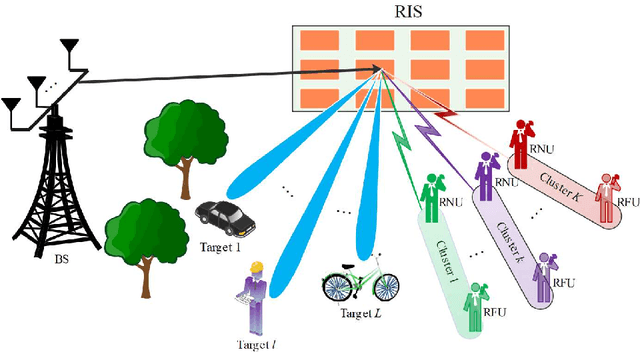
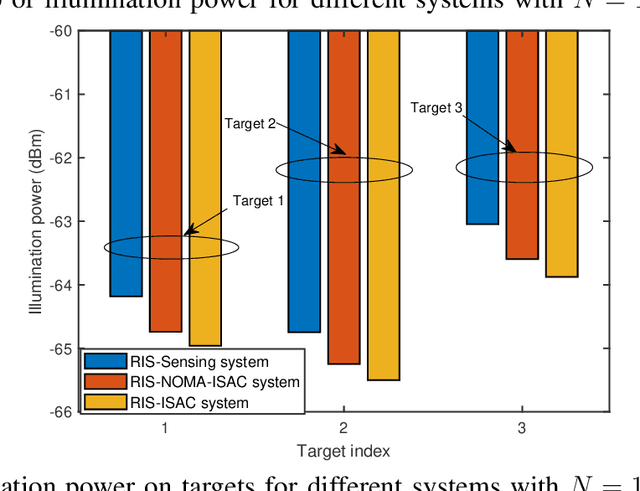
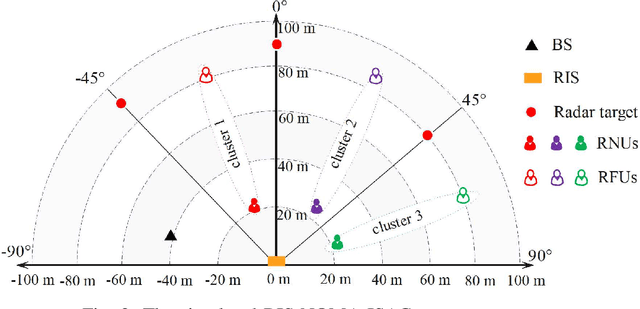
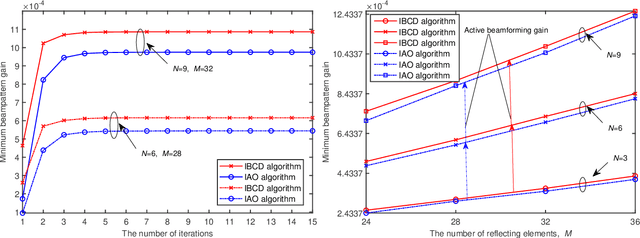
Abstract:A novel integrated sensing and communication (ISAC) system is proposed, where a dual-functional base station is utilized to transmit the superimposed non-orthogonal multiple access (NOMA) communication signal for serving communication users and sensing targets simultaneously. Furthermore, a new reconfigurable intelligent surface (RIS)-aided-sensing structure is also proposed to address the significant path loss or blockage of LoS links for the sensing task. Based on this setup, the beampattern gain at the RIS for the radar target is derived and adopted as a sensing metric. The objective of this paper is to maximize the minimum beampattern gain by jointly optimizing active beamforming, power allocation coefficients and passive beamforming. To tackle the non-convexity of the formulated optimization problem, the beampattern gain and constraints are first transformed into more tractable forms. Then, an iterative block coordinate descent (IBCD) algorithm is proposed by employing successive convex approximation (SCA), Schur complement, semidefinite relaxation (SDR) and sequential rank-one constraint relaxation (SRCR) methods. To reduce the complexity of the proposed IBCD algorithm, a low-complexity iterative alternating optimization (IAO) algorithm is proposed. Particularly, the active beamforming is optimized by solving a semidefinite programming (SDP) problem and the closed-form solutions of the power allocation coefficients are derived. Numerical results show that: i) the proposed RIS-NOMA-ISAC system always outperforms the RIS-ISAC system without NOMA in beampattern gain and illumination power; ii) the low-complexity IAO algorithm achieves a comparable performance to that achieved by the IBCD algorithm. iii) high beampattern gain can be achieved by the proposed joint optimization algorithms in underloaded and overloaded communication scenarios.
MV-FCOS3D++: Multi-View Camera-Only 4D Object Detection with Pretrained Monocular Backbones
Jul 26, 2022
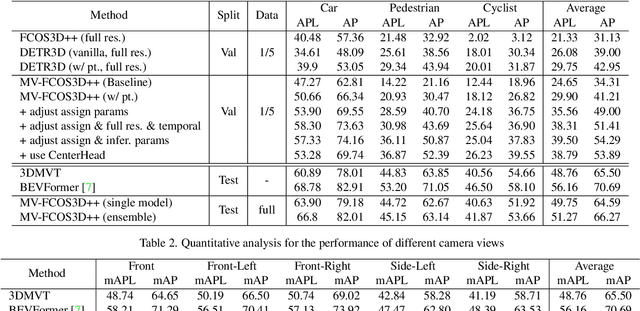


Abstract:In this technical report, we present our solution, dubbed MV-FCOS3D++, for the Camera-Only 3D Detection track in Waymo Open Dataset Challenge 2022. For multi-view camera-only 3D detection, methods based on bird-eye-view or 3D geometric representations can leverage the stereo cues from overlapped regions between adjacent views and directly perform 3D detection without hand-crafted post-processing. However, it lacks direct semantic supervision for 2D backbones, which can be complemented by pretraining simple monocular-based detectors. Our solution is a multi-view framework for 4D detection following this paradigm. It is built upon a simple monocular detector FCOS3D++, pretrained only with object annotations of Waymo, and converts multi-view features to a 3D grid space to detect 3D objects thereon. A dual-path neck for single-frame understanding and temporal stereo matching is devised to incorporate multi-frame information. Our method finally achieves 49.75% mAPL with a single model and wins 2nd place in the WOD challenge, without any LiDAR-based depth supervision during training. The code will be released at https://github.com/Tai-Wang/Depth-from-Motion.
 Add to Chrome
Add to Chrome Add to Firefox
Add to Firefox Add to Edge
Add to Edge